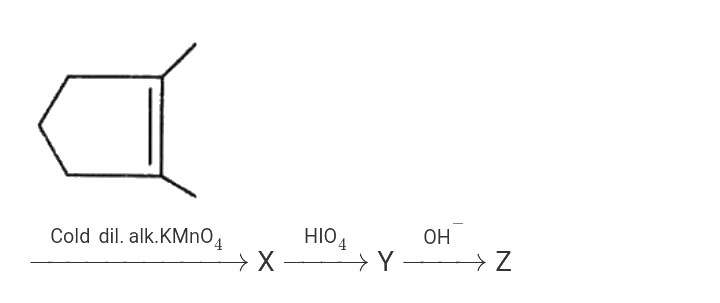Silver cyanide Δ−−→Silver+AOH−−−→X+Y+H2O In the above sequence of reaction A,X,Y are respectively.
C¯¯¯¯N,(CN)2,HCN
(CN)2,C¯¯¯¯N,OC¯¯¯¯N
(CN)2,N2OCN
(CN)2,C2−2,NO−2
The correct Answer is:B
To solve the question, we need to analyze the sequence of reactions involving silver cyanide (AgCN) and identify the compounds A, X, and Y.
1. Identify the Reaction of Silver Cyanide on Heating:
- When silver cyanide (AgCN) is heated, it decomposes into silver (Ag) and another compound. The decomposition reaction can be represented as:
2AgCNΔ−→2Ag+C2N2
- Here, the compound formed is dicyan (C₂N₂), which is represented as A.
2. Treatment of Compound A with Hydroxide Ion (OH⁻):
- The next step involves treating compound A (C₂N₂) with hydroxide ions (OH⁻). The reaction can be represented as:
C2N2+OH−→CN−+OCN−+H2O
- In this reaction, the products formed are cyanide ion (CN⁻) and isocyanate ion (OCN⁻).
3. Identify the Compounds:
- From the above reactions, we can summarize:
- A (the compound formed after heating AgCN) is C₂N₂.
- X (the cyanide ion produced) is CN⁻.
- Y (the isocyanate ion produced) is OCN⁻.
Final Answer:
- A = C₂N₂
- X = CN⁻
- Y = OCN⁻
- When silver cyanide (AgCN) is heated, it decomposes into silver (Ag) and another compound. The decomposition reaction can be represented as:
2AgCNΔ−→2Ag+C2N2
- Here, the compound formed is dicyan (C₂N₂), which is represented as A.
- The next step involves treating compound A (C₂N₂) with hydroxide ions (OH⁻). The reaction can be represented as:
C2N2+OH−→CN−+OCN−+H2O
- In this reaction, the products formed are cyanide ion (CN⁻) and isocyanate ion (OCN⁻).
- From the above reactions, we can summarize:
- A (the compound formed after heating AgCN) is C₂N₂.
- X (the cyanide ion produced) is CN⁻.
- Y (the isocyanate ion produced) is OCN⁻.
- A = C₂N₂
- X = CN⁻
- Y = OCN⁻
Similar Questions
N2+H2→[X](g)CO2,Pressure−−−−−−−→[Y]Heat−−→[Z]+H2O In the above sequence of reaction, [Y] and [Z] are respectively.
View SolutionAcetone HCN−−→(A)H3O+−−−→(B). In the above sequence of reaction A and B are :
View SolutionBeO+C→CO+XH2O−−→Be(OH)2+Y; X and Y in the above sequence are respectively
View SolutionIsopropylamine KMnO4−−−−→XH+3O−−→Y
In the above sequence X and Y are
View Solution
Cold dil.alk ,KMnO4−−−−−−−−−−−→XHlO4−−→OH−−−→Z
In the above sequence of reaction, Z is
View SolutionSO2+NO+H2O→X+ a dibasic acid XNaNH2−−−−→Y+H2O
In the above sequence, X and Y are respectively
View SolutionSiCl4H2O−−→(X)heat−−→(Y)
In the above reaction (X) and (Y) respectively are :
View Solution(CH3)2CONaCN−−−→HCI(A)H+3O−−→Δ(B)
In the above sequence of reactions, (A) and (B) are :
View SolutionIn the given reaction C6H5−CH2−CH3NBS−−→(X)Alc.KOH/Δ−−−−−−−−→(Y) In the given reaction X and Y respectively are
View Solution2DCDOOH−−−→[X]and[Y] are
View Solution